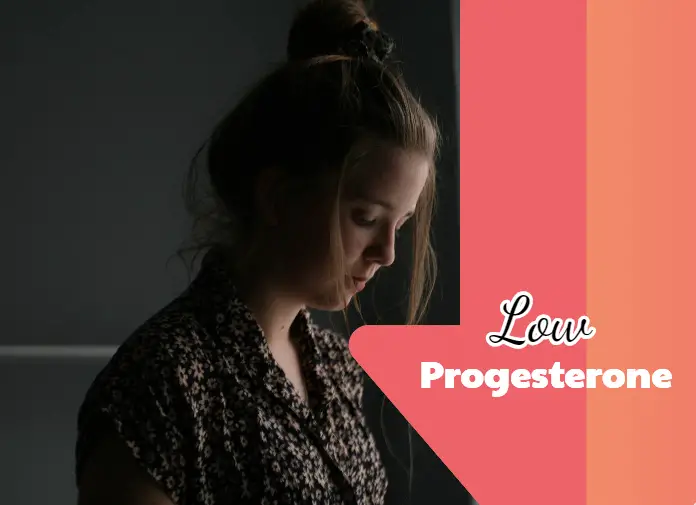Low progesterone levels affect every group whether PMSing, TTC, pregnant or menopausal. It is the hormone that plays a role in every reproductive function you name.
Causes of low levels of progesterone serve as signs of disorders. Whenever a woman complains of a gynecological problem, her estrogen-progesterone assay is the first step.
Other than reproductive role progesterone also affects the thyroid, blood sugar, and inflammatory response. Surprisingly progesterone prescription is for both those who want or avoid pregnancy.
With having a diverse role in almost every function and age group, it’s not surprising that low levels of progesterone need treatment. You cannot see that progesterone is reducing below the basal level in your blood. What are the symptoms of Progesterone deficiency? Following sections discuss each of the causes, symptoms, and treatment for low levels of Progesterone.

What does progesterone do?
Progesterone is the hormone that favors gestation by preparing the uterus. Secondary sexual characters in women are because of progesterone. Breasts development also begins when the body starts cyclically producing progesterone – puberty.
Progesterone and Ovulation
During the early stage of the menstrual cycle, progesterone doesn’t pick up much. Even on ovulation day, it is estrogen and LH that are on the higher side. After ovulation progesterone prepares the uterus lining and prevents period. Soon the cyst collapses completely, and progesterone drops. PMS and period pain is because of a change in levels of progesterone.
Progesterone And Pregnancy
Pregnancy depends on the increasing level of progesterone that maintains the lining from coming off ‘periods’. Cervical mucus starts thickening by the time because ovulation long got over. The hCG hormone rises later when the placenta formation occurs. Its progesterone that keeps scaling up until then.
Progesterone Contraception
Contraceptive pills have a combination of progestin and estradiol. A progestogen is a synthetic form of natural progesterone body synthesizes. Minipill with an only progestin has fewer side effects and can even stop ovulation.
Progesterone Effects on Menopause
Menopausal women take progesterone for reducing the symptoms. Progesterone balances the adverse effects of changes in the body due to the cessation of the menstrual cycle.
Progesterone Effects
At the stage when your body has enough progesterone, you can notice a glow on the skin. Feminine sex hormone takes care of all reproductive functions after ovulation. You will feel happier about your body. The wet feeling near cervix will gradually leave as the mucus becomes thicker and reduces in amount. Progesterone doesn’t enhance sexual activity. Serotonin levels increase, and calmness replaces anxiety and stress. You will feel sleepy due to the relaxation and its all an adaptation for storing energy for pregnancy or coming period.
Uses of Progesterone Shots, Creams, and Pills
Invariably doctors recommend progesterone pills for contraception. Minipills only progestin cab suppresses ovulation and change cervical mucus preventing contraception.
Mixing oil with progesterone for intramuscular injections is quick treatment. Low levels of progesterone on pregnancy can cause miscarriage.
Prescription of progesterone cream is for infections and treatment of the irregular period. Some women have a short menstrual cycle and get frequent menstrual periods. Low levels of progesterone can also potentially cause a short luteal phase. More menstrual cycles per year tax the body and also increases the risk of precocious menopause. Progesterone can help them lengthen the luteal period.
Symptoms of Low level Of Progesterone
If the progesterone levels are low, then all the changes that occur under the influence of progesterone secretion either don’t happen or are erratic. You can predict them after knowing the functions of progesterone. Luteal phase shortens, severe PMS, irregular menstrual period, and infertility issues arise.
Signs of a low level of progesterone in non-pregnant women
1. Loss of tuning in the menstrual cycle
Progesterone is the primary hormone in the second half of the period. Estrogen-progesterone balance serves as a marker for the brain to release reproductive hormones. When progesterone is low, the lining doesn’t form and keeps coming off in bits. Irregular periods make timing ovulation extremely difficult.
2. Short luteal phase
There are two types of menstrual cycles short and long other than regular. Whether the cycle is short depends on the length of the second half. Most women ovulate near the 14th day, but luteal phase length varies. Lack of Progesterone causes a short menstrual cycle as well as hasten cessation of the reproductive phase. Women whose ovaries get overworked have experience earlier perimenopause.
3. Random spotting or Premenstrual spotting
When progesterone drops before the actual due date, women have premenstrual spotting. Most women who are TTC assume it to be implantation bleeding. Others feel that they’re getting an early period. However, neither of them is right, and the condition requires treatment.
4. Deficient thickness of the uterine lining
A short luteal phase doesn’t permit the proliferation of uterine lining. Declining levels of progesterone cause random spotting. Further reducing the lining, light spotting occurs throughout the month. Over some time the patient will have amenorrhea. The term is for the condition when the woman stops getting period.
5. Premenstrual Dysphoric Disorder
PMSing has a lot of memes and exaggerated stuff over media. The stark reality is that some women experience anxiety, fear, and depression before the onset of the period. The idea of getting their period is so strenuous to the body that the balance starts shaking. The term for the mental and physical aggravation of PMS is a disorder. PDD is a real phenomenon and needs both psychiatric and gynecological treatment.
6. Estrogen Dominance
Progesterone deficiency leads to overpowering effects of estrogen. Weight gain, heavy bleeding, decreased libido, fibroids and endometriosis are side effects of high estrogen. Breast maturation is mainly under progesterone. Estrogen excess causes tenderness in the breast. Sagging and pain are signs of fibrocystic breasts.
7. Headache, migraine, and depression
Progesterone also affects the secretion of serotonin in the blood. Headache and migraine incidences increase in women with a low level of progesterone. Depression is directly related to serotonin levels. The fall in the pregnancy hormone also brings depression associated with the menstrual irregularities.
Low Progesterone Early Pregnancy Symptoms
1. Difficult to get pregnant
Progesterone is the pregnancy hormone. Without enough of it, getting pregnant can become a daunting task. The lining has to thicken more than non-pregnant women. It keeps enriching itself with more blood supply. Lack of progesterone forces the lining to stop proliferation and start disintegrating. Getting pregnant is difficult as the menstrual cycle goes off track. Detection of ovulation is not easy and women who TTC and have low levels of progesterone, fall into a whirlwind of doubts.
2. Pregnancy Loss
Even if pregnancy and implantation occur, it terminates. Fertility depends a lot on the rise in progesterone. If the hormone suddenly falls the lining disintegrates and aborts the embryo. Doctors give supplements of progesterone patches, cremes, and shots to such pregnant women. Until the risk of miscarriage reduces to normal level women take artificial progesterone.
3. Abnormal implantation such as ectopic pregnancy
At times the lack of progesterone leads to implantation at the wrong site. Eventually, this too leads to spontaneous loss of pregnancy. Other than that it poses a risk of bursting tubes requiring organ removal.
What Causes Low Progesterone?
1. Xenoestrogens
High estrogen can be the primary cause rather than a consequence of progesterone deficiency. There are other chemicals in your food, products and the environment. Avoiding them is possible, but often you don’t even realise that you’re taking them. Estrogen and progesterone affect each other’s blood serum levels. Thus the presence of artificial estrogen sends feedback to the brain that progesterone needs to halt.
2. Insulin resistance
The condition doesn’t let cells utilise the blood sugar. Progesterone too has similar ways to enter the cell and insulin resistance affects it equally. Other metabolic difficulties arise, and there is a loss of hormonal tuning.
3. Physical activity level at extremes
Athletes or people with excessive sedentary lifestyle affects the production of progesterone. It’s essential to have a healthy physical workout routine. When the body is active brain functions at an optimum pace. The hormones that control progesterone comes from the brain. Extreme physical activity shifts the focus of the body to the locomotive organs.
4. Nutritional deficiency
Zinc and Vitamin B6 are superfoods for women suffering from low levels of progesterone. After all, hormones are chemicals that form using essential biomolecules. Cholesterol is also an essential component of progesterone. Dieting or eating disorders also have low progesterone symptoms.
5. Stress
Mental stress is the biggest enemy of the menstrual cycle. Stress hormones affect sex hormones and health. Make sure you check your stress levels and mitigate the cause.
Normal Progesterone Levels
Progesterone levels vary during the menstrual cycle. There is no single normal value of progesterone level in a non-pregnant female. In the proliferative phase or before ovulation progesterone in blood test falls in the normal range of 0.2-1 ng/mL. Luteal phase progesterone is highest in non-pregnant women going up to 5 ng/mL.
The progesterone test is scheduled a week before the menstrual period date. That’s because the progesterone level doesn’t dip suddenly and is a gradual process. The peak of progesterone is a few days before the due date. Chance of false results is less when the levels are higher. Also, progesterone has to be in sufficient quantity in the luteal phase. Usually, after menopause, progesterone levels come down in a woman.
Pregnant mothers will have 40 times higher progesterone than usual. The levels can reach up to 200 ng/mL of blood serum.
Tests that Confirm Low Progesterone
A routine blood test performed on a woman suspect of a low level of progesterone detects the blood levels of it. The name of the test is the progesterone test abbreviated PGSN.
Ideally, your progesterone should be above 1 ng/mL through most of the month. Men and kids also have progesterone but lower than women. When you time the test right before a week from the correct period due date, your tests will give the exact picture.
During pregnancy higher levels of progesterone hint at having twins. But since even singleton can raise the levels, a progesterone test isn’t used for the detection of pregnancy.
Low Progesterone Treatments and Remedies
Natural ways of treating progesterone insufficiency include exercising, taking supplements and cutting down stress. Supplements for increasing progesterone levels contain Vitamin B, Vitamin C, and zinc. Often the three take long to cure the condition. One cannot afford to wait for the results in a situation such as pregnancy or PPD.
There are quick ways to treat low progesterone levels using hormonal therapy. You can take topical cremes or patches to place near the vagina. Suppositories are put inside and have a quicker action.
Prescription of Depo-Provera is also effective. One shot is given at intervals of 3 months. Oral contraceptive pills containing only progesterone are also one of the options.
Hormonal therapies have their set of side effects. Overdose poses a risk of high blood pressure, stroke, and cancer of the reproductive tract. Other common side effects include acne and weight gain.
Can You Naturally Increase Progesterone Levels?
Many women near menopause or not being able to conceive are recommended progesterone creams and pills. Menopausal women have to take both estrogen and progesterone in combination. While you may be doubtful about taking progesterone pills there are many natural remedies to try.
Increasing the intake of magnesium and zinc rich foods can help you regain your progesterone levels. The condition of estrogen dominance for long is harmful and causes obesity, heavy menses, irregular periods, low libido and premenstrual traumatic stress disorder.
Here are 10 things you must try to naturally increase your progesterone levels back to normal:
Lifestyle Changes For Low Progesterone
1. Reduce body fat and maintain a healthy body
Maintaining your weight has more to do than simply make you look good. Progesterone has the functions of using body fat and helping regulate fat metabolism. When the levels are low it gets burdened or vice versa when too much of fat burden it and decreases the levels overusing it.
The conclusion is weight and Progesterone levels in your body are in balance. Relaxing exercises like yoga, pilates, and swimming will calm your body and help maintain your weight.
2. Cut drinking
Alcohol is known to increase estrogen levels. The action of alcohol on the brain numbs it towards the natural balance of hormones in the body. Thus progesterone levels are lowered and estrogen rises up several folds. You must try to quit drinking totally in your reproductive switch age periods such as menopause and pregnancy. Alcohol during pregnancy is harmful to the fetus too.
3. Rethink your contraception choice
Contraceptives are nothing but artificial hormones that alter the body’s receptivity towards sperms and pregnancy. Barrier methods such as condoms and valves are best in every aspect. They do not interfere with natural hormonal balance and are more effective. Condoms are most effective after sterilisation in preventing pregnancy. Shots and implants are the most tricky forms of contraceptives that have side effects leading to hormonal imbalance.
Dietary Changes for Low Progesterone
4. Eat a magnesium rich diet
Magnesium has a massive role in regulating the production and circulation of progesterone. It affects brain glands and other menstrual cycle processes like ovulation. The daily requirement of magnesium for an adult is 320 mg per day. Taking in less than that can cause deficiencies symptoms of reduced progesterone levels. Foods that are rich in magnesium include legumes, Tofu, spinach, quinoa, almonds, avocado and dark chocolate.
Food Magnesium obtained
Dark chocolate – 64mg per 1oz serving
Tofu – 53mg per 3-4 ounce
Lentils – 120 mg per 1 serving
5. Include vitamin B6 supplements
The daily requirement of vitamin B 6 is 1.3-1.5 mg for women above 19 years of age. Vitamin B 6 is known for its uses in PMS, postpartum recovery and menopause and contraception side effects. All of these uses point to its ability to boost the progesterone levels. Taking in 200 mg or more of vitamin B 6 rich food can boost progesterone and suppress estrogen.
Foods that are rich in vitamin B 6 include cereals, liver, meat, banana leaves, poultry, and fish. For a vegan lifestyle, these may not sound interesting and so you’ve carrots. Take them as snack, soup or salads.
6. Stop using plastic containers
Endless studies and warnings have been published and yet people fail to grasp the hazards of plastic products. To the extent now people don’t hesitate using any random plastic case for heating their food in microwave appliances. Plastic packaging interferes with the food contents and robs them of their nutritive value. That’s the crudest and basic explanation of the danger posed by plastic containers.
Remove all plastic food containers from your fridge and kitchen. Plastics also are a big source of xenoestrogens – artificial estrogen, that exert a pseudo estrogen dominance on progesterone.
7. Cut sugar, and processed food products
Processed food for the same reason of xenoestrogens is a habit you must quit earliest. The byproducts of packaged food with preservatives and hormones are xenoestrogens. Not only that, but the enormous amount of free radicals generated also harms the body’s defence system. Processed meat and ready to eat food products have a large number of sugars added. These can knock out your insulin activity and pose threats of other metabolic disorders.
8. Take in the right amount of zinc
Zinc in your blood is essential for progesterone. The reason why zinc levels drop soon is that it cannot be stored for long in the body. Your daily requirement is just 8 mg per day. But this amount of zinc is crucial for all hormones. It is an important cofactor for many enzymes in your body with different functions. Foods that are rich in zinc include ricotta cheese, lamb, cocoa, mushroom, kefir, seeds, and shellfish. You can select any of these for a day or based on your dietary preferences. Most people take a combination of iron, magnesium and zinc supplements.
9. Start taking herbal tea
Caffeine has adverse effects on fertility and is known for increasing estrogen levels. Switching to herbal tea not only alleviates side effects of caffeine but has other mind boosting effects. Along with caffeine your favorite Starbucks or some other café takeaway coffee has lots of sugar as lactose and other additives. Herbal tea of chasteberry has many other benefits along with enhancing natural progesterone.
10. Omega 3 fatty acids
These fats are your skin’s, immune system’s, reproductive organ’s best friends. Salmons are loaded with omega fatty acids. And if you’re looking for a vegan food rich in omega fatty acids then evening primrose oil is an alternative. Most reproductive hormones are steroids in compositions. Thus taking the right omega 3 fatty acids or omega 6 fatty acids helps to increase the levels of raw materials for their production. Other foods that are rich in omega fatty acids include flaxseed, margarine, canola oil, tofu, and eggs.





![Implantation Bleeding With Twins [How long does IB last with twins?] Implantation Bleeding With Twins](https://www.pregnanteve.com/wp-content/uploads/2019/01/implantation-bleeding-with-twins-218x150.jpg)



